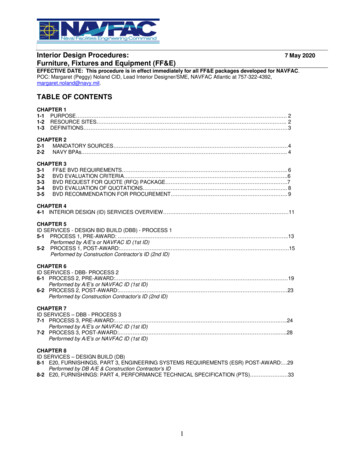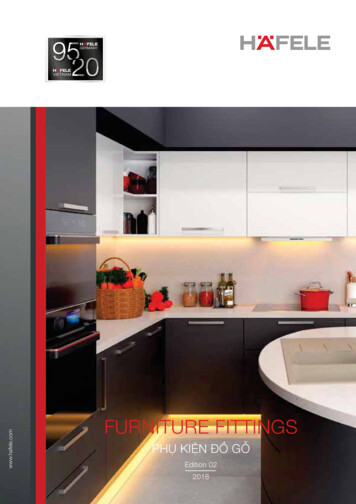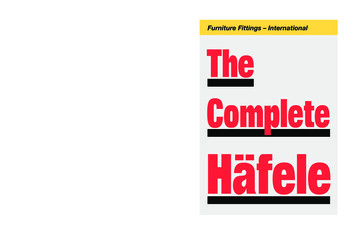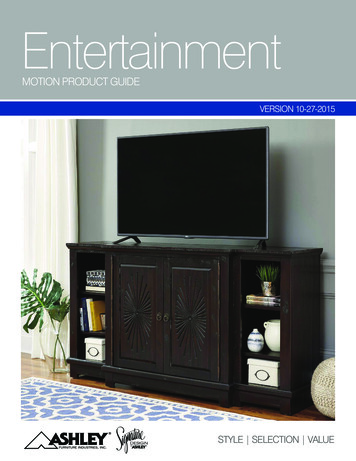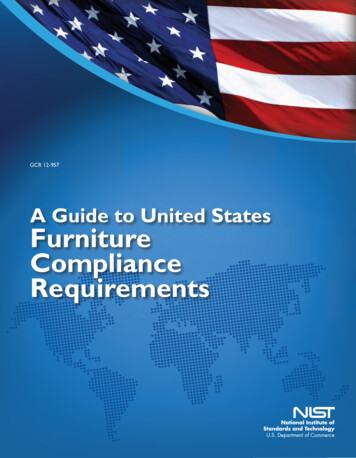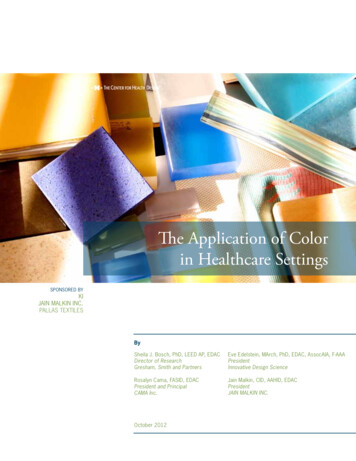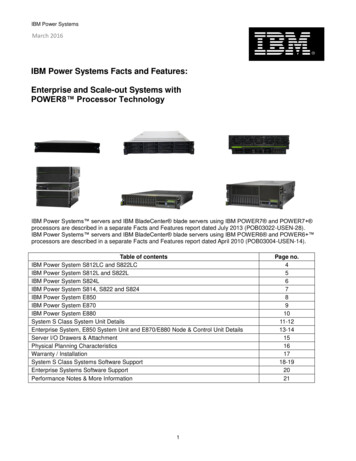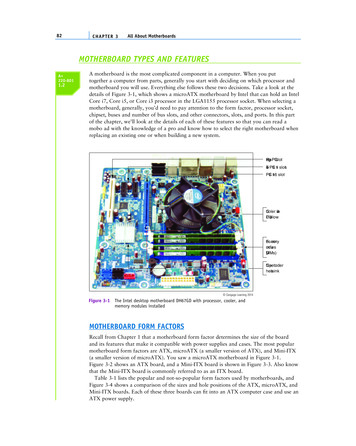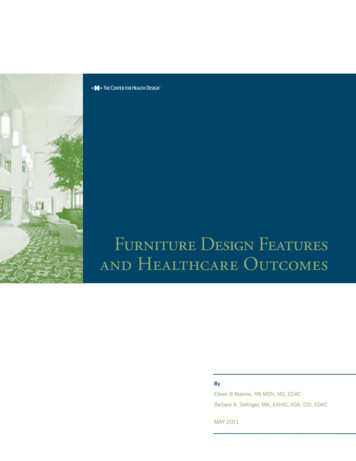
Transcription
Furniture Design Featuresand Healthcare OutcomesByEileen B Malone, RN MSN, MS, EDACBarbara A. Dellinger, MA, AAHID, IIDA, CID, EDACMAY 20111
Furniture Design Features and Healthcare OutcomesFurniture Design Featuresand Quality CareQuality care delivery continues to challenge healthcare leaders. The Society ofActuaries (2010) commissioned a medical claims-based study revealing that 1.5 million avoidable medical errors added 19.5 billion to the healthcare bill nationwide. Inspite of intense efforts to improve patient safety and care outcomes since the Instituteof Medicine published its report on medical errors over a decade ago (IOM, 1999),many chronic problems remain stubbornly unsolved, such as the failure to reducepostoperative bloodstream and urinary tract infections (AHRQ, 2010). Landrigan andcolleagues (2010) found 25.1 harms per 100 admissions at 10 North Carolina hospitalsover six years, 63 percent of which were thought to be preventable. The Department ofHealth and Human Services’ Inspector General found that 13.5 percent of hospitalizedMedicare patients experienced adverse events, and another 13.5 percent experiencedtemporary harm, 44 percent of which were thought by physician reviewers to be preventable (Levinson, 2010). These results continue to occur despite a vast array of patient safety improvement interventions during the past decade (Watcher, 2010).One of the many reasons for the slow progress in performance improvement may reflect the lack of complete scrutiny and consequent understanding of all the variablesand their interrelatedness that shape the complex systems of healthcare delivery. JamesReason (2000) hypothesized that healthcare accidents and errors occur as a result oforganizational vulnerabilities. A combination of active failures (unsafe acts by thoseproviding care) and latent conditions (termed, resident pathogens) or contributingdormant system conditions (such as chronic understaffing, inexperience, physical environment, and inadequate equipment and furniture), when combined under the rightcircumstances, can enable a hazard to slip through an organization’s flawed defenses.Such active failures and conditions result in patient injury and harm, as shown inFigure 1, an adaptation of Reason's (2000) Swiss cheese model of system accidents.Complete understanding of these system vulnerabilities requires human factors engineering—an approach that examines human capabilities and limitations with regardto products, processes, systems, and work environments—to maximize safety, reliableperformance, and effectiveness and to reduce operational errors, operator stress, fa-AbstractV Introduction1
Furniture Design Features and Healthcare Outcomestigue, and training and product liability (Henricksen, et al, 2009; Center for SystemsReliability, 2010). High-risk industries like aviation have long understood the rolethat the physical environment plays in supporting preferred human responses.FIGURE 1OrganizationalVulnerabilitiesand Poor OutcomesTriggers/HazardsLocal care preferencesand uninformed patientsPoor patient handoffs, mixed teammessages, safety culture deficitsInjury and harmInadequate staff training, testing,procedures, surveillancePoorly designed and maintained physical environment,which includes furnitureIn the past quarter century, the healthcare industry has begun to embrace a growingbody of work that examined the relationship between the physical environment, humanresponses, and consequent healthcare outcomes. Evidence-based design (EBD)—or theprocess of basing decisions about the built environment on credible research to achievethe best possible outcomes (Goetz, et al, 2010)—is being used by a growing field ofhealthcare architects, practitioners, researchers, and administrators to better understandthe impacts of the healthcare environment on healthcare outcomes, including patientsafety outcomes (Malone, 2010). Maximizing infrastructure investments like the building, technology, equipment, and furniture to achieve strategic outcomes requires an internal synergy of effort between leaders who can transform organizational culture and astaff that can reengineer clinical and administrative processes, as depicted in Figure 2.Using a multidisciplinary team to execute and institutionalize the work , all ofwhich is based on evidence-based research, pre and post occupancy measures areused to track desired outcomes, the results of which ultimately further EBD science. Additional information about the Evidence-Based Design Model can be foundin The Center for Health Design’s Evidence-Based Design Study Guide 1, page 76(Goetz, et al, 2010) at http://edac.healthdesign.org/EDAC StudyGuide1.pdfAbstractV Introduction2
Furniture Design Features and Healthcare OutcomesDisciplinedteamwork,execution nd cultureStrategic Goals:improve patient,staff, andresource hnologyequipmentfurniturercseaReResearchFIGURE 2Evidence-BasedDesign sModified from the Evidence-based Design Model in Malone, E., Mann-Dooks, J. R., & Strauss, J. (2007).Evidence-based design: Application in the MHS (Military Health System). Falls Church, VA: Noblis, p.12.Objects, such as furniture, also require careful EBD research to fully understandthe role those objects play in realizing desired patient and staff outcomes. Furniturewill be bought and replaced multiple times during the 30-year-plus-lifetime of mosthealthcare facilities. A typical new 200,000 square foot, 120-bed inpatient hospitalmay have over 1,600 individual pieces of furniture. Healthcare administrators oftenconsider furniture a sunk cost, similar to walls, lighting, and heat; a facility musthave furniture in order to serve patients, families, and the healthcare team. The highrisk healthcare industry demands much from these common objects, ranging fromembodying an organization’s brand, providing patient comfort and support duringstressful times, enabling staff to work efficiently and safely as a team, and perhapsmost importantly, not contributing to patient and staff and organizational harm.Facility managers, designers, and others charged with the responsibility of recommending furniture purchase options for c-suite approval face a dizzying assortmentof choices, complicating the furniture evaluation and selection process. First-timecosts frequently dictate furniture selection that overlooks facility life cycle costs andorganizational performance improvement goals. The purpose of this paper is to describe the creation of an Evidence-Based Design Furniture Checklist, based on current EBD research findings and industry standards. Healthcare leaders can use thelist to make informed furniture investment decisions to improve healthcare outcomesAbstractV Introduction3
Furniture Design Features and Healthcare Outcomesacross the furniture life cycle. We conclude the paper with recommendations for future EBD furniture research, government and industry standards development, andfurther checklist development.Developing an Evidence-Based Design Furniture ChecklistRecent attention to furniture’s impact on sustainability goals, coupled with thehealthcare industry’s focus on patient safety, has opened the door to a broader consideration about the role furniture might play to improve patient, staff, and resourceoutcomes. As a component of a comprehensive plan to improve targeted healthcareoutcomes, the Evidence Based Design Furniture Checklist was created as a tool to facilitate the best healthcare furniture purchases across the facility life cycle. Furniturein this context includes the more common objects, such as chairs, sofas, tables, systems, and built-in furniture; it does not include the patient bed (which has becomemore equipment-like) or carts that support medical procedures.The checklist was developed using EBD research results, industry standards, andFacility Guideline Institute requirements and recommendations. Although initiallydeveloped for use by healthcare leaders, administrators, and facility managers, thechecklist may also provide a communication tool to stimulate discussion amongdesign team members and manufacturers, as they strive to provide clients with furniture that enables healthcare quality and safety outcomes and provides a good investment. The checklist can be used during any phase of the furniture life cycle fromstrategic planning and programming, through design, and during operations overthe average 30-year life span for all types of healthcare facilities, such as when: Evaluating manufacturer product brochures and websites Meeting with manufacturers and furniture dealers to evaluate their furniture Examining existing facility furniture for life expectancy Working with healthcare facility infection control and safety committees Working with interior designers to evaluate proposed furniture features, roomlayout and product specification Conducting a return-on-investment analysisAbstractDeveloping an Evidence-Based Design FurnitureChecklist V 4
Furniture Design Features and Healthcare Outcomes Developing contract specifications for furniture rental or purchase Completing a post-occupancy evaluationThe one-page checklist is divided into eight sections, each associated with a commonEBD goal, and 35 variables for which research evidence or an industry standard wasfound that linked a furniture feature to a healthcare outcome. It was developed usingmany of the ‘good checklist list attributes’ (described by Gawande, 2009), such as asans serif font, and the checklist purpose and use instructions placed on the reverseside. A findings scale is provided so that the user can indicate the presence or absenceof a furniture feature, if more information is needed about the item, or if the featuredoes not apply to a particular furniture type. The research supporting each variableis cited and can be found in the checklist appendix.The checklist was initially developed to support a presentation to marketing leadersat a major healthcare furniture manufacturing company (Malone, 2010). The topicof the presentation was current healthcare leaders’ challenges and the role furnituremight play with regard to healthcare outcomes. The goals and variables were created based on the presenter’s EBD knowledge and a cursory review of the literatureto identify possible furniture feature and healthcare outcome intersections. After acomprehensive review of the literature, the checklist was created and subsequentlyreviewed for clarity, practicality and usefulness by a convenience sample of 22multidisciplinary experts (listed in the acknowledgement section) As a result, thechecklist was distilled from 10 to 8 EBD goals and from 47 to 36 key variables forwhich research results or The Facility Guidelines Institute (FGI, 2010) requirementsor recommendations existed. User feedback was provided by an interior design teamwho used the checklist to evaluate furniture feature options and create furniturespecifications for several major hospital replacement projects. A final draft versionof the checklist was shared with approximately 300 Healthcare Design ’10 conference participants, who attended a presentation about the development and use of thechecklist. Attendees were asked to use the checklist in the conference exhibit hall toevaluate a furniture item and provide feedback about the checklist with regard to itspracticality, usability, and clarity. Comments and recommendations were consideredin the creation of the final EBD checklist (see Figure 3).AbstractDeveloping an Evidence-Based Design FurnitureChecklist V 5
FIGURE 3Evidence-Based DesignChecklist (See Appendixfor Instructions andreferences)Findings Scale:Present ( ), Absent (-),More Information Needed (?),Not Applicable (N/A)FindingsEBD Goals and Furniture Features1. Reduce surface contamination linked to healthcare associated infections1 2a) Surfaces are easily cleaned, with no surface joints or seams.3 4 5b) Materials for upholstery are impervious (nonporous).6 7 8c) Surfaces are nonporous and smooth.92. Reduce patient falls and associated injuries10a) Chair seat height is adjustable.11 12 13 14 15b) Chair has armrests.16c) Space beneath the chair supports foot position changes.17d) Chair seat posterior tilt angle and seat back recline facilitate patient egress.18e) Chairs are sturdy, stable, and cannot be easily tipped over.19 20 21f) Rolling furniture includes locking rollers or casters.22g) Chairs have no sharp or hard edges that can injure patients who fall or trip.3. Decrease medication errors23a) Lighting fixtures should provide 90-150 foot candle illumination and an adjustable 50-watt highintensity task lamp for furniture with built-in lighting that is used in a medication safety zone.24 25b) Furniture is configurable to create a sense of privacy to minimize visual distractions andinterruptions from sound and noise during medication transcription, preparation, dispensing,and administration activities.26 274. Improve communication and social support for patients and family members28a) Furniture can be configured into small flexible groupings that are easily adjusted toaccommodate varying numbers of individuals in a variety of healthcare settings.29 30 31b) Wide-size and age variations are supported.32c) Acoustic and visual patient privacy are supported.33 34 35 36 37 385. Decrease patient, family member, and staff stress and fatigue38a) Materials suggest a link to nature.39 40 41 42 43b) Appearance is attractive and non-institutional.44 45 46 47c) Furniture is tested for safe and comfortable use by all, including morbidly-obese individuals.48 49 506. Improve staff effectiveness, efficiency, and communicationa) Furniture is easily adjustable to individual worker’s ergonomic needs.51b) Design enables care coordination and information sharing.52 53c) Materials are sound absorbing.54 54 56 57 58 597. Improve environmental safetya) Materials do not contain volatile organic compounds (VOC), such as formaldehyde and benzene.60 61 628. Represent the best investmenta) Reflect and reinforce the organizational mission, strategic goals, and brand.b) Integrate new with existing furniture and objects for facility renovation projects.c) Pieces can be flexibly reconfigured and moved to support changing and emerging missions.d) Provide casters or glides to reduce floor damage.e) Check that there are no protuberances that may damage walls; check chair rail heights.f) Manufacturer provides results of safety and durability testing.g) Manufacturer describes the specific evidence that has been used to design the product.Source: Malone, E. B. &Dellinger, B. A. (2011).Furniture design featuresand healthcare outcomes.Concord, CA: The Center forHealth Designh) Manufacturer includes a warranty appropriate to use, such as furniture used all day, every day.i) Replacement parts are available.j) Repairs can be done in the healthcare facility.k) Manufacturer or local dealer can assist with furniture repair and refurbishing.l) Environmental services (housekeeping) staff can easily maintain furniture.m) A Group Purchasing Organization (GPO) can be used when purchasing furniture.AbstractDeveloping an Evidence-Based Design FurnitureChecklist V 6
Furniture Design Features and Healthcare OutcomesFurniture Design Features and EBD Research and StandardsThe first three EBD goals on the checklist focus on key patient safety concerns thatresult in significant patient morbidity, mortality, and healthcare costs, providing animportant opportunity for healthcare furniture manufacturers. The next three EBDgoals focus on the more traditional use of furniture to improve psycho-social andwork associated outcomes. Environmental safety is described in the seventh EBDgoal. The eighth goal suggests practical considerations for making the best furnitureinvestment. In the following section, each EBD goal is stated with its checklist variables followed by a review of the supporting literature and standards.EBD Goal 1: Reduce surface contamination linked to healthcareassociated infections Surfaces are easily cleaned, with no surface joints or seams. Materials for upholstery are impervious (nonporous). Surfaces are nonporous and smooth.Healthcare Associated Infection Facts Healthcare associated infections (HAIs) are infections that patients acquire during the course of receiving treatment for other conditions within a healthcare setting (CDC, 2010). One out of every 20 hospitalized patients will contract an HAI (CDC, 2010). In 2002, approximately 1.7 million HAI incidents and 99,000 associated deaths occurred in American hospitals(Klevens, et al, 2007). Direct hospital costs for HAIs are estimated to be between 35.7 billion to 45 billion annually (Scott, 2009). A recent study examined 600,000 cases and found 2.3 million hospitalization days—accounting for 8.1 billion in hospital costs and 48,000 preventable deaths—could be attributed to HAI sepsis and pneumonia alone(Erber, et al, 2010). The Center for Disease Control director has identified the elimination of preventable healthcare infections as one ofsix ‘winnable battles’ priorities to improve the health of Americans (CDC, 2010). The American Recovery and Reinvestment Act of 2009, Public Law 111-5 authorized 59 million to supportstates in the prevention and reduction of HAIs (CDC, 2010).AbstractFurniture and EBDResearch V 7
Furniture Design Features and Healthcare OutcomesReducing surface contamination linked to healthcare associated infections (HAIs) is animportant EBD goal for which furniture design, cleaning, and maintenance plays a keyrole. (CDC, HICPAC, 2003; Bartley, Olmsted, Haas, 2010). Most HAIs are transmitted through contact with pathogens transferred from reservoirs on hand-touch sitesfound on high-risk objects close to the patient (Carling, Parry, Von Beheren, 2008;Weber, et al, 2010). High-risk objects include furniture closest to the patient, such asinpatient room chairs, over-bed tray tables, and bedside tables, as well as medical equipment features like the bed and its rails. Many pathogens cause HAIs—a growing number becoming antibiotic resistant, the most common of which can survive for monthson inanimate surfaces (Kramer, Schwebke, Kampf, 2006), as summarized in Table 1.Table 1Sample of Common Hospital Pathogens’ Survivabilityon Dry Inanimate SurfacesPATHOGENDURATION OFPERSISTENCE RANGEBacteria- Acinetobacter spp.3 days – 5 months- Enterococcus spp., including vancomycin-resistant enterococci (VRE)5 days – 4 months- Escherichia coli (E. coli)1.5 hours – 16 months- Klebsiella spp.2 hours - 30 months- Pseudomonas aeruginosa6 hours – 16 months- Serratia marcescens3 days – 2 months- Staphylococcus aureus, including methicillin-resistant7 days – 7 monthsstaphylococcus aureus (MRSA)- Streptococcus pyogenes3 days – 6.5 months-Clostridium difficile (C.diff) – spore forms5 monthsMycobacteria1 day - 4 months-Mycobacterium tuberculosisTable information adapted from, Kramer, A., Schwebke, I. & Kampf, G. (2006). How long do nosocomialpathogens persist on inanimate surfaces? A systematic review. BMC Infectious Diseases, 6, 131-133. See thearticle for survivability information about additional pathogens.Prioritized cleaning of high-risk objects provides one important tool to control HAIs, butit requires more awareness, staff training, and consistent execution (Dancer, 2009). Manyinstitutions have adopted the use of invisible fluorescent markers as a component of anenhanced monitoring program to quantitatively assess cleaning and disinfecting practiceson high-touch surfaces in hospital rooms (Carling, et al, 2006). Comprehensive, enhancedmonitoring programs that include the use of objective monitoring tools in a blame-freeculture committed to process improvement have been shown to improve disinfectioncleaning by more than 100 percent, on average
or recommendations existed. User feedback was provided by an interior design team who used the checklist to evaluate furniture feature options and create furniture specifications for several major hospital replacement projects. A final draft version of the checklist was shared with approxi

